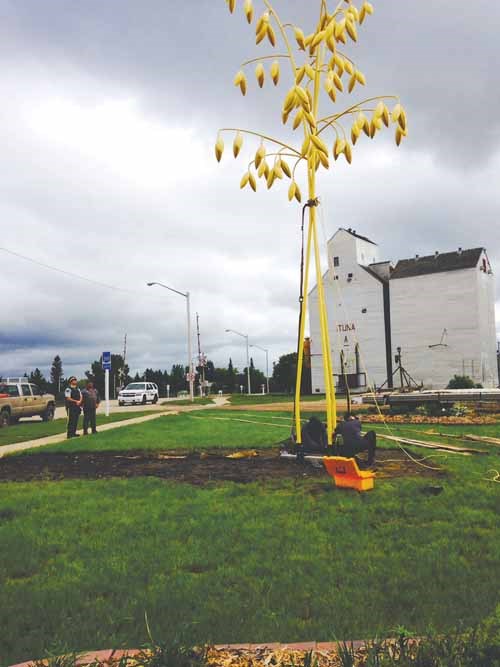Roots of the town of Ituna are similar to many prairie communities, connected by the development of Canadian railways, but Ituna now has something unique to Saskatchewan, and quite possibly to anywhere else in the world. Close to 200 showed up on Saturday, June 28 at the town's newly minted "Avena Park" to see the official dedication of a giant oat stem. ("Avena Sativa' is the scientific name for cereal oats.) The 34 foot oat stem replica is a starkly beautiful steel sculpture engineered and fabricated to the scale of an actual oat plant, by local welding instructor Dennis Muzyka. Muzyka also directed the erection of the oat stem (June 23) which he says weighs about 2000 pounds, and includes 106 oat "kernels", each weighing close to six pounds. Fabrication required some specialized metal-working techniques. The completed sculpture required about 1650 feet of weld, said Muzyka.
Avena Park, a near-by three hundred tree community orchard, and the oat stem were financed in part by grants from CN Rail, Agrium Crop Production and the Prairie Oat Growers Association (POGA) plus many public donations. Jointly, the three projects are estimated to be an investment near seventy to seventy five thousand dollars.
"But nothing ever happens if you only get money," said Ituna town councillor Terry Korchinski, who chaired the opening ceremony. "You also need boots on the ground - the people who worked behind the scenes and doing all the work." A committee of four Ituna area residents, Kris Spilchuk (chair), Allen Ivey, Ted Symchyshyn, and Lorne Fuller first approached Muzyka about two years ago to see if he would fabricate a town marker which would also commemorate the 1988 founding meeting of the Prairie Oat Growers, at Ituna.
Muzyka previously had made a steel wheat stem for his family farm (2003) Centennial year, near Goodeve. He says that experience helped with the oat project but the oat stem required unique design , special "jigs" and painting and fabrication methods. Muzyka says he "quit counting the hours at about 1000".
Mayor Joe Garchinski is the former Saskatchewan Wheat Pool elevator manager at Ituna. He recalled how after the commodity was removed from the Canadian Wheat Board jurisdiction, oats moved from being strictly a "feed" grain to becoming a desirable human food product, attractive to millers.
In the nineties, several companies had become bulk buyers of Canadian milling oats. Garchinski said (the former) Robin Hood Oats became the first major bulk buyer of milling oats but by 1996 Quaker oats was buying more oats from Ituna than anywhere else in the world.
Oat and barley breeder and University of Saskatchewan Professor Emeritus Dr. Rossnagel, said records show the first oats planted in Saskatchewan was in 1820 at Carlton House, south west of Prince Albert, then a fur trade point, which obviously kept horses and fed them oats. By 1916 3.8 million acres of oats were grown in Saskatchewan (and only 9 million wheat acres) - representing 42 per cent of the seeded acres in the province - and literally providing the feed for the "horse power" to farming. In 1944 oats hit 5.2million acres but represented a smaller percentage of cropped land.
By 1991 oat acreage had slipped to a half million acres - three percent of Saskatchewan's crop production - and (because of the relatively small oat production) virtually no provincial research funds were available for oats.
With the change in marketing of oats, says Rossnagel, by 1998 we were back up to 2 million acres, "back up to about 21 per cent of acres in the province." In 2013 oats could claim about 18 per cent of cropped acres - just under 2 million acres.
Removal of the Crow Benefit freight subsidy (in 1995) was also a major driver of change for oat marketing. Without the federal subsidy it now became much more costly to ship oats from the prairies, Alberta being a further distance from the (predominately U.S.) mills, that province drastically dropped off in oat production but it also provided incentive for Alberta oat growers to want to connect with, (and eventually join with) Saskatchewan and Manitoba growers to form an oat advocacy group, which eventually became POGA. Their first joint meeting was at Ituna in 1998 - and for that reason the giant Ituna oat plant has three main stems, representing the three prairie oat-growing provinces. Makreting clubs at Ituna,Kelliher and Foam Lake combined forces to make the first meeting happen and later continued their financial and physical support.
The first meeting resulted in formation of the Prairie Oat Growers Association which is now the umbrella for oat commissions in Manitoba, Saskatchewan and Alberta. Farmers contribute 50 cents per tonne check-off from non farm - to - farm sales. POGA co sponsors varietal, agronomic and market development with both federal and provincial governments and the oat industry.
It also collaborated with USDA, Agriculture and AgriFood Canada and other agencies to support a major study and mapping of the oat genome.



